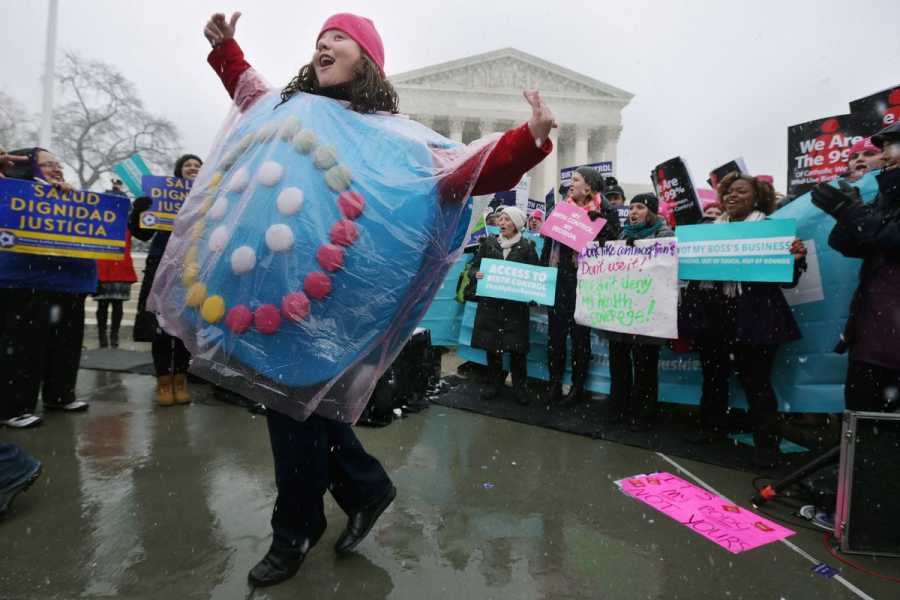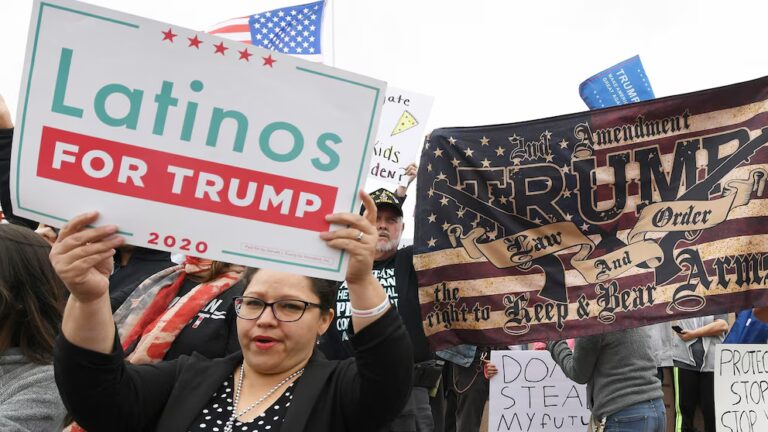With courts coming for abortion and IVF, it’s hard not to wonder what the Supreme Court will go after next.

A protester dressed as a pack of birth control pills dances in front of the US Supreme Court. Chip Somodevilla/Getty Images Ian Millhiser is a senior correspondent at Vox, where he focuses on the Supreme Court, the Constitution, and the decline of liberal democracy in the United States. He received a JD from Duke University and is the author of two books on the Supreme Court.
When the Supreme Court overruled Roe v. Wade, it swore up and down that its decision didn’t necessarily have any implications for other rights. “‘Abortion is a unique act’ because it terminates ‘life or potential life,’” Justice Samuel Alito wrote for himself and four of his Republican colleagues. He added that “our decision concerns the constitutional right to abortion and no other right” and that “nothing in this opinion should be understood to cast doubt on precedents that do not concern abortion.”
But even as Alito wrote these words, Justice Clarence Thomas drafted a concurring opinion calling upon his Court to eliminate the rights to contraception, same-sex marriage, and the right “to engage in private, consensual sexual acts.” Justice Brett Kavanaugh, meanwhile, published his own opinion disclaiming any desire to come for anyone’s marriage or birth control.
All Americans now live in a land of uncertainty, somewhere between Thomas and Kavanaugh. In Alabama, the death of Roe meant that in vitro fertilization clinics closed after that state’s justices ruled that, at least under the state law governing wrongful deaths of children, a frozen embryo has the exact same rights as a child.
The clinics are now reopening after the Alabama state legislature, chastened by a nationwide backlash against the court’s decision, enacted legislation protecting IVF. The state supreme court’s original decision targeting IVF, however, contains some language suggesting they might rule that this new state law is unconstitutional. So it is unclear whether we’ve read the last chapter in this dispute over whether women in Alabama may receive IVF care.
This also isn’t the only way the right to privacy is under threat. Red states enacted several laws forbidding physicians from providing transgender health care to children experiencing gender dysphoria. Indeed, at this very moment, the Supreme Court is considering whether to reinstate such a law in Idaho which was blocked by a lower court. (The specific issue in the Idaho case turns on a narrow procedural question, but nothing prevents this Court from using that procedural question as an excuse to reinstate the Idaho law.)
Not that long ago, it would have been hard to imagine either Alabama’s attack on IVF or the red state laws targeting trans children surviving federal judicial review.
The right to an abortion lost in Dobbs v. Jackson Women’s Health Organization (2022) was itself part of a broader “right to privacy,” which guaranteed that our most intimate, personal decisions — decisions like who we marry, who we have sex with, whether and when to have children, and, with some exceptions to prevent abuse or neglect, how we raise those children — will be made by us alone and not by the government.
As the Court said in Lawrence v. Texas (2003), “In our tradition the State is not omnipresent in the home. And there are other spheres of our lives and existence, outside the home, where the State should not be a dominant presence.”
Now, however, it is far from clear what, if any, of this right to privacy still exists. Justice Thomas proudly calls for it to be burnt to the ground. And even Kavanaugh’s more moderate Dobbs opinion may simply be a call to freeze the right to privacy in place — leaving existing freedoms like the right to same-sex marriage intact, but refusing to extend the right to privacy to previously unlitigated issues like IVF or trans health care.
Our most personal and self-defining decisions — the kinds of choices that we make alone, after praying to our own God, speaking to our own family, and consulting our own doctors — may now belong to the government.
No one knows exactly which rights are protected by the Constitution
One reason the modern right to privacy rests on shaky ground is because it is not explicitly laid out in the Constitution. The oldest Supreme Court decision protecting such a right is more than a century old, and the Constitution includes several provisions protecting so-called “unenumerated” rights that are not itemized anywhere in its text.
But one searches the Constitution in vain for specific language protecting, say, the right to choose your spouse, or the right to guide your children’s upbringing.
The Court’s earliest right to privacy decisions, moreover, are relics of an era when the justices frequently treated enumerated rights — that is, rights that are explicitly laid out in the Constitution — as optional guidelines that could be ignored.
In Meyer v. Nebraska (1923), the Court struck down a state law which forbade schoolteachers — including teachers at private schools, who are not state employees — from teaching “any subject to any person in any language [other] than the English language” before the student passed the eighth grade.
You might think this law would be struck down on First Amendment grounds, since it obviously violates the right to free speech.
But four years before Meyer, in Debs v. United States (1919), the Court held that a prominent union leader and political candidate could be sentenced to 10 years in federal prison for giving a speech opposing the draft, and this was just one of an orgy of World War I-era decisions treating the First Amendment as a virtual nullity. So teachers who wanted to educate their students in a foreign language could not rely on the right to free speech to attack Nebraska’s law.
Instead, Meyer featured the Court’s earliest articulation of what became the unenumerated right to privacy. Individuals have a right “to marry, establish a home and bring up children,” the Court said, and this right brings with it a parent’s “natural duty” to “give his children education suitable to their station in life.” To fulfill this duty, parents must also be allowed “to instruct their children” in subjects they wish those children to learn.
For the next four decades, the Court said little more about the right to privacy — although it did hold that parents have a right to send their children to private (and, specifically, Catholic) schools in Pierce v. Society of Sisters (1925). Beginning in the 1960s, however, the Court started to flesh out this right, and to include within it the right to make certain medical decisions without government interference.
The first of this second wave of right-to-privacy decisions was Griswold v. Connecticut (1965), which held that married couples have a constitutional right to use contraception.
The idea that anyone had a right to sexual autonomy of any kind — even something as seemingly noncontroversial as a married couple using birth control — was reasonably novel in the 1960s. An 1873 federal law known as the Comstock Act, a law that is still on the books, bans pretty much any kind of contraception, sex toy, abortifacient, or even art or literature depicting nudity or sex, from being mailed. And similar state laws often targeted this kind of material.
In some cases, this led to art gallery owners being convicted for selling reproductions of famous works of nude art. In other cases, it led to people arrested for providing contraceptives or other forbidden items dying by suicide after being hounded by law enforcement. Anthony Comstock, the anti-sex crusader after whom the federal law is named, once bragged that 15 people targeted by his investigations took their own lives.
Read in the light of this history, Griswold is best understood as a repudiation of Comstockery. It is also one of the Court’s first articulations of the idea that some aspects of our lives are walled off from government regulation specifically because they are private — and because there are some places where law enforcement officers simply do not belong.
“Would we allow the police to search the sacred precincts of marital bedrooms for telltale signs of the use of contraceptives?” the Court asked in Griswold, before answering that “the very idea is repulsive to the notions of privacy surrounding the marriage relationship.”
One reason to fear that this right to privacy is in danger is that one of the Court’s fullest articulations of the right’s scope came with Roe v. Wade (1973), the decision now held up as an icon of judicial overreach by the Court’s current, GOP-appointed majority. As Roe explained, this right extends to “activities relating to marriage, procreation, contraception, family relationships, and child rearing and education.”
Specifically, the Court has said that the right to privacy includes the right to marry a person of our own choosing (1967’s Loving v. Virginia, 2015’s Obergefell v. Hodges); the right to choose our own sexual partners (Lawrence v. Texas in 2003); the right to have, or not to have, children at a time of our choosing (Griswold, 1972’s Eisenstadt v. Baird, Roe); and the right to raise those children as their parents deem appropriate, with exceptions prohibiting abuse, truancy, and similar offenses (Meyer, Pierce).
Read together, these rights provide a strong basis for protecting women seeking IVF or families with transgender children. The Court has said many times that the government may not interfere in our most intimate decisions involving our families, including medical decisions.
Now, however, all of these rights are potentially threatened by a Supreme Court that has already torn away one key component of the broader right to privacy. And it is far from clear which of the remaining components will survive.
Four ways that the Supreme Court could handle the right to privacy moving forward
It’s dangerous to predict how the current Supreme Court will rule on any issue, or, at least, on any issue where the Court’s current members have not yet staked out an explicit view. The Court’s current majority has a weak attachment to “stare decisis,” the doctrine that courts should be reluctant to overrule previous decisions.
And the Supreme Court has a long history of ignoring constitutional rights even when they are explicitly protected by the Constitution — hence the World War I-era decisions suppressing the First Amendment, or the Jim Crow-era decisions nullifying amendments intended to guarantee equal citizenship to Black people.
As of now, we know, based on the concurring opinions in Dobbs, that Justice Thomas would likely abolish the right to privacy in its entirety. And we know that Justice Kavanaugh would leave some existing rights, like the right to marry whomever you choose, intact. We don’t know where the rest of the Court’s Republican majority falls along this spectrum.
That said, there are four ways that this Court might approach right to privacy cases moving forward, and at least one of these approaches could end in good outcomes for women seeking IVF treatments, or for families with transgender children.
The first possibility is that Thomas finds five votes for his sweeping assault on the right to privacy. This outcome is unlikely at the moment, given Kavanaugh’s declaration that he does not support it. But if Donald Trump wins the 2024 presidential election, he could potentially replace some of the Court’s relatively moderate members with hardliners similar to Thomas. And that would mean the death of a long list of rights, from the right to same-sex marriage to the right to contraception.
In the second and third possibilities, Kavanaugh’s approach prevails, and the Court leaves most of the privacy rights protected by existing Supreme Court precedents in place. No married couple is stripped of their marriage license and no one needs to fear a ban on legal birth control.
What distinguishes these two possibilities is how the Court reads a line in its Dobbs decision, which says that the justices will determine which unenumerated rights are protected by the Constitution by asking “whether the right at issue … is rooted in our Nation’s history and tradition.”
Broadly speaking, the idea of a right to privacy and the right to guide your own children’s upbringing first announced in Meyer are firmly rooted in American legal history and tradition. These rights have been around for more than a century, and can certainly be read broadly enough to encompass, say, the right to decide which medical treatments your child should receive if they are diagnosed with gender dysphoria.
That said, the Supreme Court has not yet read the right announced in Meyer to encompass a right to IVF, or a right to provide a child with gender-affirming health care that the government finds objectionable. So it would not be hard for the current, very conservative Supreme Court majority to rule that novel applications of the right to privacy are not part of America’s “history and tradition.”
And then there is a fourth possibility. Several conservative organizations, including groups with very close ties to Trump, see the right to privacy as a tool they can use to impose their own values on the nation.
Before we sacrifice our constitutionally protected right to privacy at the altar of gender identity politics… https://t.co/wDMwaI94Br
— Heritage Foundation (@Heritage) June 29, 2016
Thus, the Alliance Defending Freedom, a Christian-right law firm that routinely brings anti-LGBTQ cases to the Supreme Court, has argued that public schools should be forbidden from allowing transgender children to use the bathroom that aligns with their gender identity because doing so violates the privacy rights of cisgender students who do not wish to share a bathroom with their trans classmates.
The worst possible outcome for transgender youth is that the Supreme Court could transform the right to privacy, long a safeguard of LGBTQ rights, into a sword that can be wielded to force the government to adopt anti-trans policies — even in jurisdictions where transgender rights enjoy broad local support.
At least one judge, moreover, has already weaponized the right to privacy to undermine access to birth control. Matthew Kacsmaryk, a Trump judge with close ties to the religious right, ruled in 2022 that the Meyer right to decide how to raise children allows a father who objects to birth control to limit his daughters’ access to contraception.
In any event, the one thing that can be said with certainty about the current Supreme Court is that it is a chaos agent. The justices will do what they want, when they want to do it, regardless of what precedent has to say about the matter.
And all the rest of us can do is wait to see the fallout.
Sourse: vox.com






